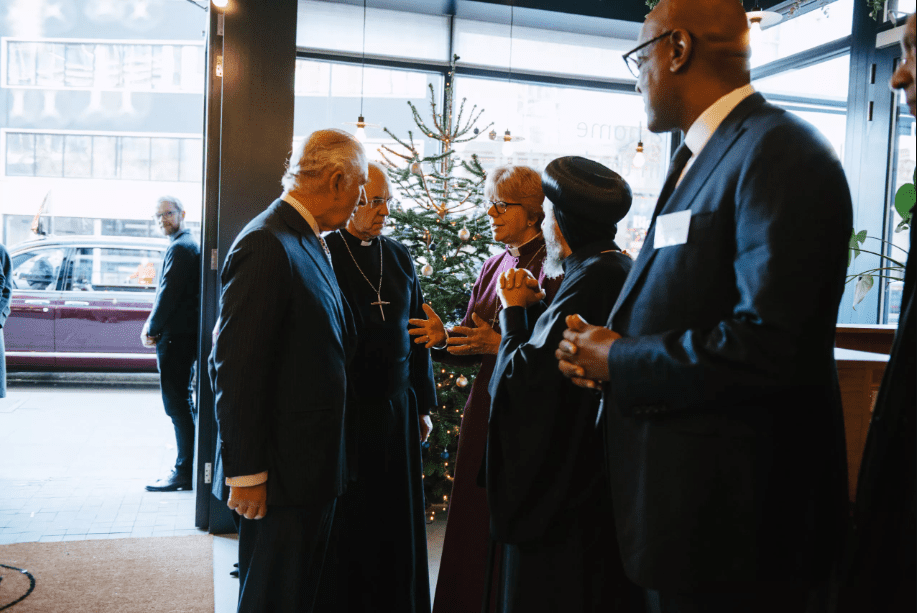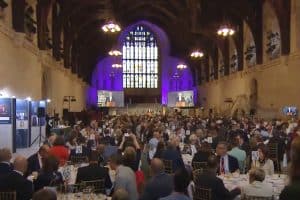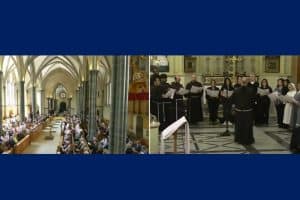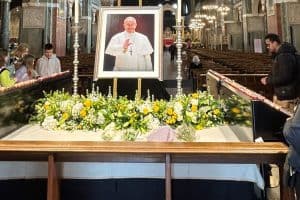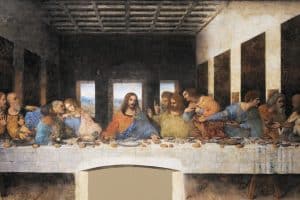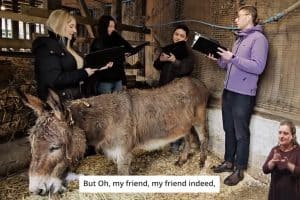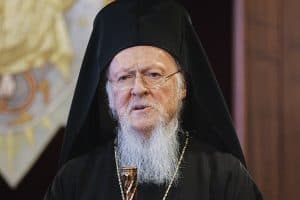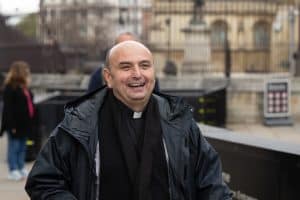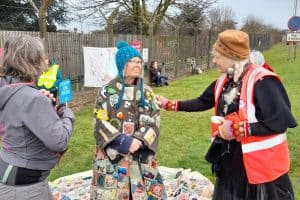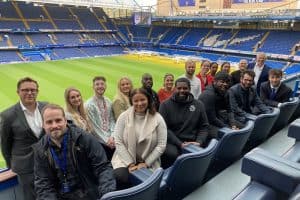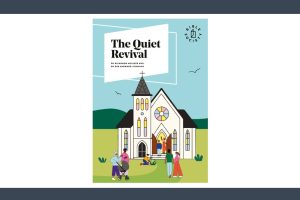Just over three months ago, King Charles pledged that he would protect the space for faith in Britain, the country he called “a community of communities”.
On 16 September, eight days after his mother’s death and his accession, the new monarch made that pledge when he held a reception for faith leaders, promising to have a special duty towards faith and diversity during his reign.
And in the run-up to Christmas, King Charles has made a point of visiting faith communities and attending religious events. He has worn a Sikh headdress, enjoyed a Jewish dance with Holocaust survivors, and sung Christmas carols.
For those who have observed the work and interests of the new king in his years as Prince of Wales, this engagement with faiths seems a natural progression of what he has been doing for the past 50 years. But now it is a more complicated balancing act. Upon becoming king, he has become supreme governor of the Church of England.
Almost 30 years ago, Charles caused Anglican eyebrows to rise when he said that he would like to be known as defender of faith, rather than the traditional defender of the faith, a title that all British monarchs have held since the time of Henry VIII. In an interview with his biographer Jonathan Dimbleby, he said that when it came to the monarch’s role, “I would much rather it was seen as defending faith itself which is so often under threat in our day”.
Yet when he acceded to the throne in September, he was proclaimed defender of the faith — and then to say at his Buckingham Palace reception for faith leaders that not only was he a committed Anglican but that because of his own beliefs and position as sovereign, he was concerned about others and respecting their faith.
His faith engagements, in the past few months, have been a mixture of the highly conventional and the more unusual, with a strong focus on faith in action.
The more conventional visits have included a trip to York Minster to unveil a statue of his mother, the Cenotaph service on Remembrance Sunday, and a service in the Chapel Royal at St James’s Palace for members of the Order of Merit. Visits in the UK to mark towns being given city status have taken in a church visit. But even one of the conventional Anglican trips — to Westminster Abbey for a carol service, to be televised on Christmas Eve — came with a twist.
Amid all the traditional readings and carols was a more radical choice — the poem, Refugee, by Malcolm Guite. The order of service said “Dame Kristin Scott-Thomas DBE reads, at his Majesty the King’s suggestion”, and the lines included:
We think of him as safe beneath the steeple,
Or cosy in a crib beside the font,
But he is with a million displaced people
On the long road of weariness and want.
The King’s more unusual visits, focusing on faith in action, saw him engaging with several projects to help refugees. On 30 November, he opened the Ukrainian Welcome Centre, at the Ukrainian Catholic Cathedral, off Oxford Street in London, where refugees from the war in Ukraine can visit for advice, get help with items such as clothing, and find a listening ear. It was the second time that he had visited since the war began in February; the first trip to the cathedral was in early March.
Bishop Kenneth Nowakowski, the Ukrainian Eparchial Bishop of the Holy Family Eparchy in London, was the host on both occasions. “That first time we were all a little frayed around the edges after what had just happened in Ukraine,” he said, “and it was a comfort to have him come and talk to us. This latest time he spoke to every single person there, including mothers from Ukraine and our volunteers.”
Bishop Kenneth was one of the faith leaders who attended the Buckingham Palace reception in September. “To hear him express himself as a guarantor of faith — to hear that from the sovereign — was extraordinary. I expected him to speak about faith but to say that was a particular delight.”
The King also met refugees during his visit to the JW3 community centre in north London, which is a focus for both the Jewish community and its outreach work. The centre runs a bakery where asylum-seekers help with the baking for foodbank deliveries. Among those he met were people from Sudan and Nigeria who help in the bakery, while donations for JW3’s foodbank were handed over to the centre from the boot of the King’s car. As part of the visit, the King also took part in the centre’s pre-Hanukkah reception for Holocaust survivors, and participated in traditional Jewish dancing. Among his dancing partners was Anne Frank’s stepsister, Eva Schloss, 93, who endured years of incarceration in concentration camps and has since worked for peace.
The visit, according to Oliver Marcus, the marketing manager of JW3, was important because the King’s visit endorsed the approach of the centre. “We are very much open to all, Jewish and non-Jewish,” he said. “We are inward-looking to our own community but also outward-looking so we run a local foodbank and he was very interested in that.”
According to Mr Marcus, the visit was also vital at a time when antisemitism was still a problem. “The visit was affirmative. The highest power in the land was saying that we are welcome and part of this country, that we are as much a part of Britain as anybody else.”
The King has long been interested in Jewish matters, making visits to synagogues and to other Jewish organisations, including those working with Holocaust survivors. Earlier this year seven portraits that he commissioned of Holocaust survivors went on display at the Queen’s Gallery in London.
According to Zaki Cooper, a communications consultant who has worked for both Elizabeth II and the former Chief Rabbi, Lord Sacks, the King’s concern about antisemitism was in part inspired by his paternal grandmother, Princess Alice, who hid and protected Jewish people in Athens during the Second World War, and is listed at the Holocaust memorial site of Yad Vashem in Israel as one of the Righteous Among the Nations, for the risks she took in saving Jews.
“The King’s engagement with Jewish people and his concern about antisemitism makes a huge impact on our community,” said Cooper, who also noted the King’s interest in other faiths too. “He isn’t ticking boxes. It goes deeper than that. He feels a kinship and a comfort with religious communities,” he said.
Other visits to social action projects taken by the King since he acceded to the throne included one to King’s Cross Church in London, where he opened its King’s House centre, and the nearby Ethiopian Fellowship Church. There were conversations with the volunteers at King’s Cross Church, which hosts a variety of community programmes, including meetings for parents, carers and children, as well as work with refugees, through a café, and debt relief and prison chaplaincy work.
King’s Cross Church looks more like a welcoming shop than a church, and is a “plant church”, set up in the tough neighbourhood surrounding King’s Cross Station by St Mary’s, Bryanston Square, 12 years ago. King Cross Church is an Anglican church, with a strong evangelical flavour, and the King was joined on his visit by the Archbishop of Canterbury, Justin Welby, and the Bishop of London, Dame Sarah Mullally. With Archbishop Anba Angaelos, the Coptic Orthodox Archbishop of London, they all adjourned to the Ethiopian Fellowship Church nearby for an Advent service.
Marking Advent with different Christian communities, and often focusing on the plight of persecuted Christians, has become a tradition of the King in recent years. This Advent season, though, has seen him have a particular focus on other religions too. It took him to a Sikh temple in Luton in early December, where he met representatives of different religions in the Bedfordshire town. As well as the newly built Guru Nanak Gurdwara’s religious spaces, he also saw the community food hall and heard about the vaccination programme that the Gurdwara ran, targeting the BAME population during the Covid pandemic.
During the pandemic, the King was seen frequently using the traditional Sat Sri Akal gesture, as an alternative to shaking hands, and used it again during his visit, when he also wore a traditional Sikh headdress as a gesture of humility and respect.
At his September Buckingham Palace reception, he spoke of the importance of respect: “I hold myself bound to respect those who follow other spiritual paths.” He placed this in the context of his own beliefs: “Diversity is not just enshrined in the laws of our country; it is enjoined by my own faith. As a member of the Church of England, my Christian beliefs have love at their very heart.”
The next main faith event for the King will be Christmas Day, surrounded by cameras at St Mary’s Church, Sandringham, for the usual royal family photocall. Then in the afternoon, the nation will hear his first Christmas message. If he follows in his mother’s footsteps, it will be about Christian faith — and the importance of faith diversity in Britain today.

